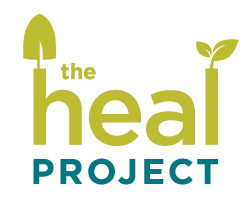Bees at The HEAL Project Farm
By Julie Mathiasen
On the first Saturday in April, Pat Morrissey (“The Bee Lady”) drove up to Glenn, California to purchase bees from Koehnen to start our hive at The HEAL Project Farm. She brought back 3,000 bees and a queen bee for our hive. We set up a hive near the Hedgerow at The Farm. The Hedgerow is a row of native plants that attract pollinators like bees and butterflies.
Pat and two friends suited up in their bee suits for protection and gently put the bees into the hive. The boxes that are stacked on top of one another to make the hive are called “supers.” Pat provided sugar water for the bees. The sugar water helps the bees build their comb on the frames in each super. Four supers with frames have been added to our hive as more and more baby bees hatch. This provides room for honey production and the brood area inside the hive.
Left: Julie in her bee suit. Right: Julie adding frames to one of the hives.
On June 17th, our bees “swarmed,” which means that part of the bee colony formed a new queen and left the hive in search of a new home. They didn’t end up going very far, landing in a Ceanothus bush about 15 feet from the original hive, fairly low to the ground. When the bees are swarming, they are very relaxed and will generally not sting. They formed a thick mass around one of the main branches of the bush. The mass of bees was about 15 inches wide and about 3 feet long. Pat estimated that there were about 7,000 bees that swarmed!
Left: The bees swarming in a bush. Right: Bees migrating from the ground into the hive to be with the queen.
Pat doing some preparation.
Pat and I suited up and positioned a new hive below the swarm on the branch. I filmed while Pat tenderly put her gloved hands around the bees and lowered them into their new home. After about four huge handfuls of bees were lowered into the hive, Pat gave the branch a shake to loosen the last of the bees, which then fell gently into the hive. Some of the bees were on the ground and started climbing up the edge of the hive to get inside. The bees could smell that the queen was inside the hive, so they wanted to be in there, too. We misted the bees with a bit of water to keep them from stressing out and give them a bit of a drink as they cleaned the mist off their wings. It took about an hour for all of the bees to arrive safely inside the new hive. When most of the bees had entered the hive, we covered it up with an inner cover and then a hive cover.
Bee hives at The HEAL Project Farm!
By that time, the bees in our original hive were foraging for nectar and pollen as usual. We decided to come back at dusk, when we knew that all of the swarmed bees would be inside of their hive to keep warm for the night, to move the hive to its new location. We then added a second super to the new hive and put a strap around the hive to keep it together. We lifted the whole hive up and placed it on top of a hive stand located about ten feet away from the original hive in the Hedgerow. Now there could be upwards of 10,000 very happy bees at The Farm doing their thing: gathering nectar and pollen and making it into honey!
—
Julie has a degree in Horticulture from Cal Poly, San Luis Obispo. Prior to joining The HEAL Project, Julie worked as an Educator with UC Elkus Ranch. She also works as After School Director at an elementary school. Julie has a passion for teaching children where their food and fiber comes from.





